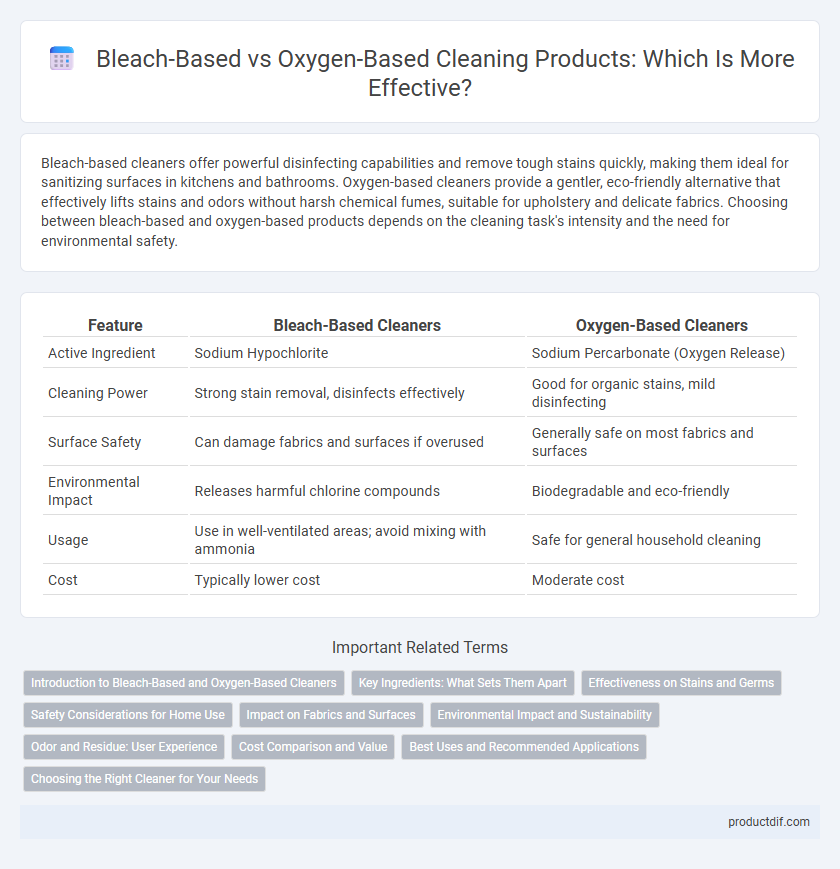Bleach-based cleaners offer powerful disinfecting capabilities and remove tough stains quickly, making them ideal for sanitizing surfaces in kitchens and bathrooms. Oxygen-based cleaners provide a gentler, eco-friendly alternative that effectively lifts stains and odors without harsh chemical fumes, suitable for upholstery and delicate fabrics. Choosing between bleach-based and oxygen-based products depends on the cleaning task's intensity and the need for environmental safety.
Table of Comparison
| Feature | Bleach-Based Cleaners | Oxygen-Based Cleaners |
|---|---|---|
| Active Ingredient | Sodium Hypochlorite | Sodium Percarbonate (Oxygen Release) |
| Cleaning Power | Strong stain removal, disinfects effectively | Good for organic stains, mild disinfecting |
| Surface Safety | Can damage fabrics and surfaces if overused | Generally safe on most fabrics and surfaces |
| Environmental Impact | Releases harmful chlorine compounds | Biodegradable and eco-friendly |
| Usage | Use in well-ventilated areas; avoid mixing with ammonia | Safe for general household cleaning |
| Cost | Typically lower cost | Moderate cost |
Introduction to Bleach-Based and Oxygen-Based Cleaners
Bleach-based cleaners contain sodium hypochlorite, a powerful disinfectant effective against bacteria, mold, and viruses, often used for whitening and stain removal on hard surfaces. Oxygen-based cleaners utilize hydrogen peroxide or percarbonate compounds, releasing oxygen to break down organic stains and lift dirt, making them safer for colored fabrics and environmentally friendly. Both types offer distinct advantages depending on the cleaning task, with bleach excelling in sterilization and oxygen cleaners favored for gentle yet effective stain removal.
Key Ingredients: What Sets Them Apart
Bleach-based cleaners primarily contain sodium hypochlorite, which delivers powerful disinfection and stain removal by breaking down organic material and killing bacteria and viruses. Oxygen-based cleaners rely on hydrogen peroxide or sodium percarbonate, releasing oxygen bubbles that lift and oxidize stains while being environmentally friendly and safer for delicate surfaces. The key difference lies in bleach's strong chemical potency versus oxygen-based agents' gentler, eco-conscious stain removal and sanitizing action.
Effectiveness on Stains and Germs
Bleach-based cleaners excel in eliminating tough stains and killing a wide range of germs due to their strong oxidizing properties, making them highly effective for disinfecting surfaces. Oxygen-based cleaners use hydrogen peroxide or similar compounds that break down organic stains with less harsh chemicals, providing a safer option for delicate fabrics and surfaces while still offering moderate germ-killing power. Selecting between bleach and oxygen-based products depends on the cleaning task's intensity and the need for both stain removal and microbial sanitation.
Safety Considerations for Home Use
Bleach-based cleaners contain sodium hypochlorite, which can release harmful chlorine gas if mixed with acids or ammonia, posing respiratory risks and skin irritation hazards in home use. Oxygen-based cleaners use hydrogen peroxide or sodium percarbonate, offering safer decomposition into water and oxygen without toxic fumes, making them preferable for households with children or pets. Users should always follow label instructions and ensure proper ventilation regardless of the cleaner type to minimize health risks.
Impact on Fabrics and Surfaces
Bleach-based cleaners, typically containing sodium hypochlorite, provide strong stain removal but can weaken fabric fibers and discolor delicate surfaces over time. Oxygen-based cleaners, using hydrogen peroxide or sodium percarbonate, offer gentler stain removal and maintain fabric integrity while being safe on most surfaces. Choosing the right cleaner depends on the fabric type and surface durability to avoid damage and prolong item lifespan.
Environmental Impact and Sustainability
Bleach-based cleaners often contain chlorine compounds that release toxic fumes and create harmful byproducts, contributing to water pollution and posing risks to aquatic life. Oxygen-based cleaners utilize hydrogen peroxide, breaking down into water and oxygen, making them more biodegradable, eco-friendly, and safer for sustainable cleaning practices. Choosing oxygen-based products reduces environmental impact by minimizing chemical residues and supporting safer wastewater treatment.
Odor and Residue: User Experience
Bleach-based cleaners emit a strong, chlorine-like odor that can be overpowering and linger on surfaces, often causing discomfort for users sensitive to harsh smells. Oxygen-based cleaners provide a milder, more pleasant scent and typically leave no harsh chemical residue, enhancing overall user satisfaction during and after cleaning. Residue from bleach can sometimes cause discoloration or surface damage, whereas oxygen-based options tend to break down into non-toxic byproducts, promoting a safer and more comfortable cleaning experience.
Cost Comparison and Value
Bleach-based cleaning products generally offer a lower upfront cost compared to oxygen-based options, making them more budget-friendly for routine cleaning tasks. Oxygen-based cleaners, while initially pricier, provide greater long-term value through their versatility, environmental safety, and effectiveness on a broader range of stains and surfaces. Evaluating total cost of ownership and cleaning needs reveals oxygen-based products often deliver enhanced value despite higher initial investment.
Best Uses and Recommended Applications
Bleach-based cleaners excel in disinfecting surfaces, removing mold, and whitening fabrics in laundry, making them ideal for bathrooms, kitchens, and heavily stained areas. Oxygen-based cleaners provide gentle yet effective stain removal and odor elimination, suitable for delicate fabrics, carpets, and general household cleaning. Selecting bleach-based or oxygen-based products depends on surface sensitivity, desired disinfecting power, and fabric compatibility for optimal cleaning results.
Choosing the Right Cleaner for Your Needs
Bleach-based cleaners excel at disinfecting and removing tough stains, making them ideal for sanitizing kitchens and bathrooms where germs are a concern. Oxygen-based cleaners offer a gentler, eco-friendly alternative, effectively breaking down organic stains on fabrics and surfaces without harsh chemicals. Assess the specific cleaning task, surface type, and safety considerations to select a cleaner that balances effectiveness with environmental and health impacts.
Bleach-based vs Oxygen-based Infographic

 productdif.com
productdif.com